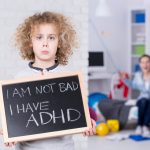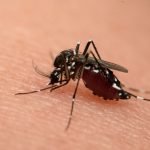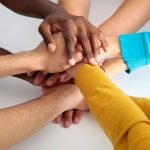Working with LGBTQ Patients: the Importance of Increasing Cultural Competency – Part 1
Abigail Egginton, ND
Naturopathic Perspective
The dearth of research on the health of the LGBTQ population1 has been improved upon in recent years, and what this work reveals is that our LGBT patients need better care.1 Naturopathic doctors, especially knowledgeable in the social determinants of health and the physiological toll of societal discrimination, should be clear on the latest findings in this new area of research.
The LGBTQ population is now considered to be a health disparity group, as set forth by the National Institutes of Health (NIH) this past year.2 This suggests that we must make greater efforts to know and see our LGBTQ patients and provide the care that is most appropriate for them, which means understanding their particular risk factors. With this announcement by the NIH, the acronym SGM was used in lieu of LBTQ. Standing for “sexual and gender minorities,” this term is inclusive of people who may identify with terms not included in the acronym LGBTQ (lesbian, gay, bisexual, transgender, questioning).
Risks & Disparities
Numerous studies have now brought to light the public health concerns faced by the SGM population across all age brackets. While we may be aware that men who have sex with men (MSM) are at greater risk of contracting HIV, some of these statistics are not as familiar. And even our understanding of those at high risk of contracting HIV has been expanded by examining the overlap between ethnic and SGM groups. In a study published in February of 2016, the Centers for Disease Control and Prevention (CDC) revealed that black men who have sex with men are significantly more likely to contract HIV in their lifetime than are Hispanic or white MSM.3 The study found that one-half of all black men who have sex with men will contract the virus. Other notable risk factors have been brought to light by this first National Health Interview Survey, which for the first time included questions on sexual orientation.3
Smoking & Substance Abuse
SGM people are more likely to smoke, use drugs, and consume alcohol.4 For example,19.8% of lesbian and bisexual women smoke cigarettes, as compared with 13.4% of heterosexual women; and 21.5% of gay and bisexual men smoke, as compared with 16.6% of heterosexual men.4 These higher rates of smoking seen in the LGBTQ population are now understood to be associated with the higher levels of psychological distress experienced by this minority group.5 A systematic review of 25 studies (that did not include transgender people) found that the risk of dependence on alcohol and other substances was 1.5 times higher in LGB people as compared with heterosexual people.6
Mental Health & Suicidal Ideation
SGM individuals bear higher burdens of depression and anxiety and engage in more self-harming behaviors.6 In an interesting study published in 2016, researchers at Drexel University reported that bisexual women are significantly more likely to have suicidal thoughts, as compared with straight women and lesbians.7 The data on over 2500 subjects ages 14-24 were collected by primary-care physicians and examined depression, anxiety, and substance use, in addition to suicidal ideation.
There are different thoughts as to why bisexuals seem to be worse off than lesbians with regard to mental health. Hypotheses include that bisexuals may be perceived to be heterosexual, or that individuals who identify as bisexual may still struggle with how to classify their sexual orientation, or bisexuals may not feel that they are welcomed – due to perceived discrimination – into the LGBT community in the same way as those who identify as homosexual.7
Young gay and bisexual men were also found to have significantly higher rates of depression and distress when compared with their straight peers. Again, bisexual men reported higher incidence of suicidal ideation compared to straight and gay men.7
A survey of 704 SGM people and heterosexual cisgendered adult women, published in February of 2017, found that transgender individuals are 2.4 times more likely to have an unmet need for mental healthcare when compared to the heterosexual women in the study, while bisexual and pansexual women were 1.8 times more likely to have an unmet need for mental healthcare.8
Bullying & Victimization
LGBT youth are more than twice as likely to have attempted suicide when compared to their peers; this is likely related to the discrimination and victimization they face.9 Over half of LGBTQ youth face harassment at school.10 Approximately half of all LGBT adults have experienced bias-related harassment.11
In the 2015 National School Climate Survey, 85% of LGBTQ students reported experiencing verbal harassment, and 27% said they were physically harassed because of their sexual orientation.12 A 2016 CDC report on the sexuality of high school kids found that youth who identified as LGB were more likely to be victims of bullying and sexual violence at school and were significantly more likely to have suicidal ideation than their straight peers.13 The report also found LGB students were more likely to be forced to have sex or to be victims of dating violence. Compared to youth who identified as heterosexual, LGB youth were 2 times more likely to feel sad or hopeless.
The data for this report came from the 2015 National Youth Risk Behavior Survey,14 which does not yet include questions for students who identify as trans; however, we know from other studies that youth who identify as trans are very likely to experience discrimination and victimization (eg, 78% of trans kids have been bullied at school15) and are also more likely to attempt suicide.16 The report also failed to survey students who had dropped out of school which, the CDC suggests,17 may include a disproportionate percentage of LGBT-identifying youth.
Overall Health in Older SGM Adults
LGBTQ youth are not the only ones internalizing the effects of societal discrimination. In the first national and longitudinal study of LGBT adults, ages 50-100, the National Institute on Aging surveyed 2400 diverse LGBT individuals and found that 2.4% of older adults currently identify as LGBT and that these individuals face higher rates of disability, cardiovascular disease, depression, and social isolation when compared to their heterosexual peers.18 Forty-one percent of those surveyed had a disability, which was significantly higher than for heterosexual adults of the same age. Corroborating previously mentioned findings, this survey found that bisexual older adults face worse health than their lesbian and gay peers, and experience more internalized stigma, less social support, and lower socioeconomic status.18
Similar to other studies, 82% of these older adults reported having been victimized at least once in their life, while 68% had experienced verbal harassment.18 Perhaps related to these experiences, the survey found that 21% of older LGBT adults failed to disclose their sexual or gender identity to their doctors, and 15% were reluctant to access healthcare outside the LGBT community.18 Seventy-eight percent of those in long-term care facilities expressed feeling uncomfortable being open about their identity to healthcare staff.18 Researchers at Columbia University’s School of Public Health found that LGBT people who live in communities with high levels of anti-LGBT prejudice die approximately 12 years earlier than peers in other locales.19
As this population ages, their risk of certain cancers, among other health concerns, increases. This is amplified because lesbians are far less likely to receive screenings for cervical cancer compared to their heterosexual counterparts.20 Given that older Americans who identify as LGBT are more likely to be single, the prognosis of a cancer diagnosis may be impacted by factors compounded by their sexual orientation. A 2017 National Cancer Institute-sponsored study found that women who were socially isolated were 34% more likely to die from their breast cancer compared to women with more significant social networks.21
Practitioner Bias
These staggering findings strongly suggest healthcare providers can no longer be avoidant about a patient’s sexual orientation, as our interactions with SGM patients can significantly influence these statistics.
And yet research has now confirmed what we might imagine to be the case regarding our own internal biases. While earlier research demonstrated the reality of our racial biases in the realm of healthcare,22 a 2015 paper published in the American Journal of Public Health exposed the implicit biases of healthcare providers to the LGB population.23 Biases towards trans patients were not explored in this study, though surveys of trans patients have found that 19% of trans people have been refused medical care in the past simply for being transgender.24 So, the assumption that significant biases exist is a fair one.
The recent implicit bias study surveyed medical doctors, nurses, mental health care providers, and others from 2006 to 2012 and used the Implicit Association Test to reveal unconscious bias.23 The study found a moderate to strong preference among providers for treating straight people over gay and lesbian patients by those who self-identified as heterosexual.23 This finding was also demonstrated in reverse; doctors who identified as gay or lesbian preferred treating patients who identified similarly. But because doctors who identify as LGBT are in the minority, the implicit bias on the part of heterosexual providers was the most notable finding. The bias was seen across medical professions, though women and mental healthcare practitioners were less likely to have strong implicit biases. The study did not look at how this bias impacted care; however, given the research illustrating the negative experiences of many LGBT patients in medical settings, it is important to be aware of. Awareness of personal bias, promoting objective decision-making, and seeking educational experiences that will counter stereotypical assumptions and experiences are all necessary actions to counter the effects revealed in this survey. To explore your own internal biases, you can take these tests online at: www.implicit.harvard.edu. Different tests focus on different groups.
A survey of British clinicians in the United Kingdom revealed that 24% of staff working with patients have heard a colleague make a negative remark about lesbian, gay, or bisexual people, and that 20% have heard such remarks regarding trans patients.25 While I would like to think that a similar survey done in the United States might have smaller percentages, a 2015 NIH-sponsored study concomitantly suggests otherwise: 80% of 1st-year medical students were found to have implicit bias against lesbians and gays.26 The fact remains that whether biased thoughts are vocalized or internalized, the negative effects of these sentiments on patients are significant and should be considered.
It would be fair to conclude that these biases contribute – at best – to the ambivalence that LGBT people feel in seeking out the recommended preventative care. Add this to the fact that LGBT individuals are less likely to be insured,27 and we have seriously inadequate care for this demographic group.
Impact on Care
While the study about implicit bias did not examine its possible impact on care, a number of studies have. In a 2016 study, for example, researchers found that only 18% of bisexual female youth had spoken to their doctor about their sexual identity and that the same percentage considered their healthcare provider knowledgeable about LGBT health.28 If doctors do not know who their SGM patients are, they cannot fully address the appropriate risk factors for the patients they are seeing. Lesbian women, for example, have been less likely to request the HPV vaccination despite being at greater risk, as a population, for cervical cancer.29
The negative biases impact patients’ health outside of the doctor’s office as well. A study published in January of 2017 found that behaviors that put MSM at higher risk of contracting HIV are related to the stigma that they experience.30
State laws can magnify the effects of these biases. In Tennessee and Mississippi, certain care providers are lawfully able to discriminate against LGBT patients.31 Other states have tried to pass similar legislation and, given our current political climate, it is not unlikely that the safety of LGBT patients seeking care can vary widely from state to state. Additionally, the rise in hate-crimes and calls to LGBT suicide prevention hotlines since the November election suggests that the health of this population is especially vulnerable at present.32
This is especially concerning to trans patients who need prescriptions for and regular monitoring of their hormone therapy. Many endocrinologists treating trans patients have not received formal training in supporting trans patients through hormonal gender transition. Moreover, a small survey conducted in 2016 by Dr Michael Irwig, at George Washington University School of Medicine, found that one-third of polled endocrinologists refused to provide care to transgender patients.33 Thankfully, of the endocrinology training programs surveyed, 72% do provide training on transgender health. So, perhaps better care is on the way!
Closing Comments
This is the first part of a 2-part article discussing competent care for LGBTQ patients. In Part 2 of this article, I will discuss the negative experiences reported by LGBTQ patients in seeking medical care, as well as the shortcomings that currently exist in providing appropriate care for these patients. This should serve as inspiration for improving our own literacy of LGBTQ-specific healthcare needs. In Part 2 I will also make suggestions and provide resources for expanding our understanding of how we can better support and care for our LGBTQ patients.
References:
- Institute of Medicine. The Health of Lesbian, Gay, Bisexual, and Transgender People: Building a Foundation for Better Understanding. Washington, DC: National Institutes of Health; 2011. Available at: https://www.ncbi.nlm.nih.gov/books/NBK64806/. Accessed April 15, 2017.
- National Institute on Minority Health and Health Disparities. Director’s Message: Sexual and Gender Minorities Formally Designated as a Health Disparity Population for Research Purposes. October 6, 2016. NIMHD Web site. https://www.nimhd.nih.gov/about/directors-corner/message.html. Accessed April 15, 2017.
- Gonzales G, Przedworksi J, Henning-Smith C. Comparison of Health and Health Risk Factors Between Lesbian, Gay, and Bisexual Adults and Heterosexual Adults in the United States: Results from the National Health Interview Survey. JAMA Intern Med. 2016;176(9):1344-1351.
- Gruskin EP, Greenwood GL, Matevia M, et al. Disparities in smoking between the lesbian, gay and bisexual population and the general population in California. Am J Public Health. 2007;97(8):1496-1502.
- Rosario M, Schrimshaw, EW, Hunter J. Cigarette smoking as a coping strategy: negative implications for subsequent psychological distress among lesbian, gay, and bisexual youths. J Pediatr Psychol. 2011;36(7):731-742.
- King M, Semlyen J, Tai SS, et al. A systematic review of mental disorder, suicide, and deliberate self harm in lesbian, gay and bisexual people. BMC Psychiatry. 2008;8:70.
- Shearer A, Herres J, Kodish T, et al. Differences in Mental Health Symptoms Across Lesbian, Gay, Bisexual, and Questioning Youth in Primary Care Settings. J Adolesc Health. 2016;59(1):38-43.
- Steele LS, Daley A, Curling D, et al. LGBT Identity, Untreated Depression, and Unmet Need for Mental Health Services by Sexual Minority Women and Trans-Identified People. J Womens Health (Larchmt). 2017;26(2):116-127.
- Russell ST, Joyner K. Adolescent Sexual Orientation and Suicide Risk: Evidence from a National Study. Am J Public Health. 2001;91(8):1276-1281.
- The Gay, Lesbian, & Straight Education Network (GLSEN). The 2013 National School Climate Survey: The Experiences of Lesbian, Gay, Bisexual, and Transgender Youth in Our Nation’s Schools. New York, NY: GLSEN; 2014. Available at: https://www.glsen.org/sites/default/files/2013%20National%20School%20Climate%20Survey%20Full%20Report_0.pdf. Accessed April 15, 2017.
- Herek GM. Hate crimes and stigma-related experiences among sexual minority adults in the United States. J Interpers Violence. 2008;24(1):54-74.
- The 2015 National School Climate Survey: The Experiences of Lesbian, Gay, Bisexual, and Transgender Youth in Our Nation’s Schools. New York, NY: GLSEN; 2016. Available at: http://tinyurl.com/ydy3vdoa. Accessed April 20, 2017.
- Centers for Disease Control and Prevention. First National Study of Lesbian, Gay, and Bisexual High School Students’ Health. August 11, 2016. CDC Web site. https://www.cdc.gov/nchhstp/newsroom/2016/lgb-youth-report-press-release.html. Accessed April 20, 2017.
- Centers for Disease Control and Prevention. Morbidity and Mortality Weekly Report (MMWR). Youth Risk Behavior Surveillance—United States, 2015. June 10, 2016. CDC Web site. https://www.cdc.gov/mmwr/volumes/65/ss/ss6506a1.htm?s_cid=ss6506_w. Accessed April 20, 2017.
- Haas AP, Rodgers PL, Herman JL. Suicide Attempts Among Transgender and Gender Non-Conforming Adults. January 2014. The Williams Institute UCLA School of Law. Available at: http://williamsinstitute.law.ucla.edu/research/suicide-attempts-among-transgender-and-gender-non-conforming-adults/. Accessed April 20, 2017.
- James SE, Herman JL, Rankin S, et al. The Report of the 2015 U.S. Transgender Survey. U.S. Transgender Survey (USTS). Washington DC: National Center for Transgender Equality; 2016.
- Kann L, Olsen EO, McManus T, et al. Sexual Identity, Sex of Sexual Contacts, and Health-Related Behaviors Among Students in Grades 9-12 – United States and Selected Sites, 2015. MMWR Surveill Summ. 2016;65(9):1-202. Available at: https://www.cdc.gov/mmwr/volumes/65/ss/ss6509a1.htm?s_cid=ss6509a1_w. Accessed April 20, 2017.
- Fredriksen-Goldsen KI, Kim HJ, Emlet C, et al. The Aging and Health Report: Disparities and Resilience among Lesbian, Gay, Bisexual, and Transgender Older Adults. Seattle, WA: Institute for Multigenerational Health; 2011. Available at: http://age-pride.org/wordpress/wp-content/uploads/2012/10/Executive_Summary10-25-12.pdf. Accessed April 20, 2017.
- Hatzenbuehler ML, Bellatorre A, Lee Y, et al. Structural stigma and all-cause mortality in sexual minority populations. Soc Sci Med. 2014;103:33-41.
- Tracy JK, Lydecker AD, Ireland L. Barriers to Cervical Cancer Screening Among Lesbians. J Womens Health (Larchmt). 2010;19(2):229-237.
- Kroenke CH, Michael YL, Poole EM, et al. Postdiagnosis social networks and breast cancer mortality in the After Breast Cancer Pooling Project. Cancer. 2017;123(7):1228-1237.
- Blair IV, Steiner JF, Fairclough DL, et al. Clinicians’ implicit ethnic/racial bias and perceptions of care among Black and Latino patients. Ann Fam Med. 2013;11(1):43-52.
- Sbain JA, Riskind RG, Nosek BA. Health Care Providers’ Implicit and Explicit Attitudes Toward Lesbian Women and Gay Men. Am J Public Health. 2015;105(9):1831-1841.
- Grant JM, Mottet LA, Tanis J. Injustice at Every Turn: A Report of the National Transgender Discrimination Survey; 2011. National Center for Transgender Equality. Available at: http://www.thetaskforce.org/static_html/downloads/reports/reports/ntds_full.pdf. Accessed April 20, 2017.
- Somerville C. Unhealthy Attitudes: The treatment of LGBT people within health and social care services. 2014. Available at: http://www.stonewall.org.uk/sites/default/files/unhealthy_attitudes.pdf. Accessed April 22, 2017.
- Burke SE, Dovidio JF, Przedworksi JM, et al. Do Contact and Empathy Mitigate Bias Against Gay and Lesbian People Among Heterosexual First-Year Medical Students? A Report from the Medical Student CHANGE Study. Acad Med. 2015;90(5):645-651.
- Gates GJ. In U.S., LGBT More Likely Than Non-LGBT to Be Uninsured. August 26, 201 26, 2014. Gallup. Available at: http://www.gallup.com/poll/175445/lgbt-likely-non-lgbt-uninsured.aspx. Accessed April 20, 2017.
- Arbeit MR, Fisher CB, Macapagal K, Mustanki B. Bisexual Invisibility and the Sexual Health Needs of Adolescent Girls. LGBT Health. 2016;3(5):342-349.
- Agenor M, Peitzmeier S, Gordon AR, et al. Sexual Orientation Identity Disparities in Awareness and Initiation of the Human Papillomavirus Vaccine Among U.S. Women and Girls: A National Survey. Ann Intern Med. 2015;163(2):99-106.
- Balaji AB, Bowles KE, Hess, KL, et al. Association Between Enacted Stigma and HIV-Related Risk Behavior Among MSM, National HIV Behavior Surveillance System, 2011. AIDS Behav. 2017;21(1):227-237.
- Green E. When Doctors Refuse to Treat LGBT Patients. April 19, 2016. The Atlantic. Available at: http://tinyurl.com/y8w459bq. Accessed April 22, 2017.
- Hatewatch Staff. Update: Incidents of Hateful Harassment Since Election Day Now Number 701. November 18, 2016. Southern Poverty Law Center Web site. https://www.splcenter.org/hatewatch/2016/11/18/update-incidents-hateful-harassment-election-day-now-number-701. Accessed April 20, 2017.
- Irwig MS. Transgender Care by Endocrinologists in the United States. Endocr Pract. 2016;22(7):832-836.
Image Copyright: <a href=’https://www.123rf.com/profile_rawpixel’>rawpixel / 123RF Stock Photo</a>
 Abigail Egginton, ND, graduated from Bastyr University in 2011. She currently practices in Pleasantville, NY, and Ridgefield, CT, and also teaches at the College of New Rochelle in NY. Dr Egginton’s practice focuses on oncology, women’s health, and pediatrics, in addition to LGBTQ health. Dr Egginton is passionate about supporting the health of the LGBTQ community and has volunteered for Camp Ten Trees in Seattle in this capacity.
Abigail Egginton, ND, graduated from Bastyr University in 2011. She currently practices in Pleasantville, NY, and Ridgefield, CT, and also teaches at the College of New Rochelle in NY. Dr Egginton’s practice focuses on oncology, women’s health, and pediatrics, in addition to LGBTQ health. Dr Egginton is passionate about supporting the health of the LGBTQ community and has volunteered for Camp Ten Trees in Seattle in this capacity.









